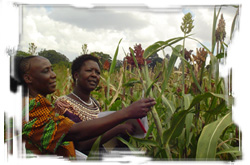CIMMYT E-News, vol 2 no. 12, December 2005
 African maize farmers who will grow transgenic maize varieties resistant to one of the crop’s most damaging pests—the maize stem borer—learn that to keep borers at bay, some must survive.
African maize farmers who will grow transgenic maize varieties resistant to one of the crop’s most damaging pests—the maize stem borer—learn that to keep borers at bay, some must survive.
Maize stem borers destroy approximately 12% of Kenya’s maize crop annually—losses valued at more than US$ 50 million. Under the Insect Resistant Maize for Africa (IRMA) project, the Kenya Agricultural Research Institute (KARI), CIMMYT, and the Syngenta Foundation for Sustainable Agriculture have worked in partnership since 1999 to offer farmers maize varieties that resist borers. They are drawing this resistance from several sources, including maize landraces and experimental varieties and even a common soil bacterium, Bacillus thuringiensis (Bt). The latter produces its own, natural insecticide: a protein that perforates borer larvae’s stomach lining, causing them to starve. There are several types of this protein and each is very selective, affecting certain species of borers but no other animals. Researchers have taken the gene responsible for the protein and put it into maize, thereby obtaining a plant that borers of the targeted species cannot safely eat.
The resistance from Bt is effective until, through a chance mutation, an individual borer emerges that can beat it. Borer offspring with the same mutation will eventually become more numerous than other borers, making the Bt-based resistance useless.
A safe haven for borers
Farmers in developed countries who grow Bt maize usually protect its effectiveness through use of “refugia”—fodders or cereal crops that foster the survival and reproduction of Bt-susceptible borers. IRMA recently sponsored a two-day workshop on refugia at KARI’s Kitale center. The 50 participants—19 researchers, and 17 extension staff, and 14 farmers from 9 districts of North Rift Valley and 2 neighboring districts—learned about the progress in the development of insect resistant maize and the importance of refugia.
“It’s not hard to find refugia for stem borers; the challenge is to find refugia that both work and are acceptable to farmers,” says KARI entomologist Dr. Margaret Mulaa, who organized the Kitale workshop, and leads the insect resistance management (IRM) component of the IRMA project. “The refugia species have to fit in with the farmers’ cropping systems.”
All workshop participants took to the field to evaluate and score potential crops and varieties that could be used as stem-borer refugia on farms. They ranked the top 5 each from among 15 sorghum and 18 grass varieties, and 4 maize varieties for their attractiveness as food, fodder, or refugia for stem borers.
Farmers lead the way scoring refugia
The farmers raced ahead of the other two groups, doing what comes most naturally to them: visually assessing the yield and disease resistance of the sorghum varieties; squeezing the sorghum grains between two fingers and tasting them to judge texture and flavor; splitting open maize and grass stalks to assess moisture content and borer damage; and examining fodder crops for yield, vigor, and traits like hairiness and moisture content—important indicators of palatability for livestock. “Bana grass yields well and is not too hairy, so my cows enjoy it,” said Philomen Berut, a farmer from South Nandi who has received two awards for the best livestock at the Kitale Agricultural show.
More than 26 different criteria were given for selecting the sorghum varieties, but the major ones were high yield, early maturity, tolerance to pests and diseases, short height (which helps plants resist lodging), and tolerance to bird damage.
And the winners?
All three groups ranked the ‘local brown’ and ‘local red’ sorghum varieties among the top five favorites. Four improved Napier varieties (Kakamega 1 & 2, Napier 16798 and 16837) were also ranked top by all three groups. The popular maize hybrid H614 was ranked among the best five refugia species for its stable yield, lush foliage, and good cobs.
Mulaa finds this type of information extremely important for developing an IRM strategy that farmers will actually use. “By understanding farmers’ choices and criteria early enough, the resistance management package that IRMA will introduce along with Bt maize will have the farmer’s hand in its design, making it more likely to succeed.”
For more information contact Stephen Mugo (s.mugo@cgiar.org)

